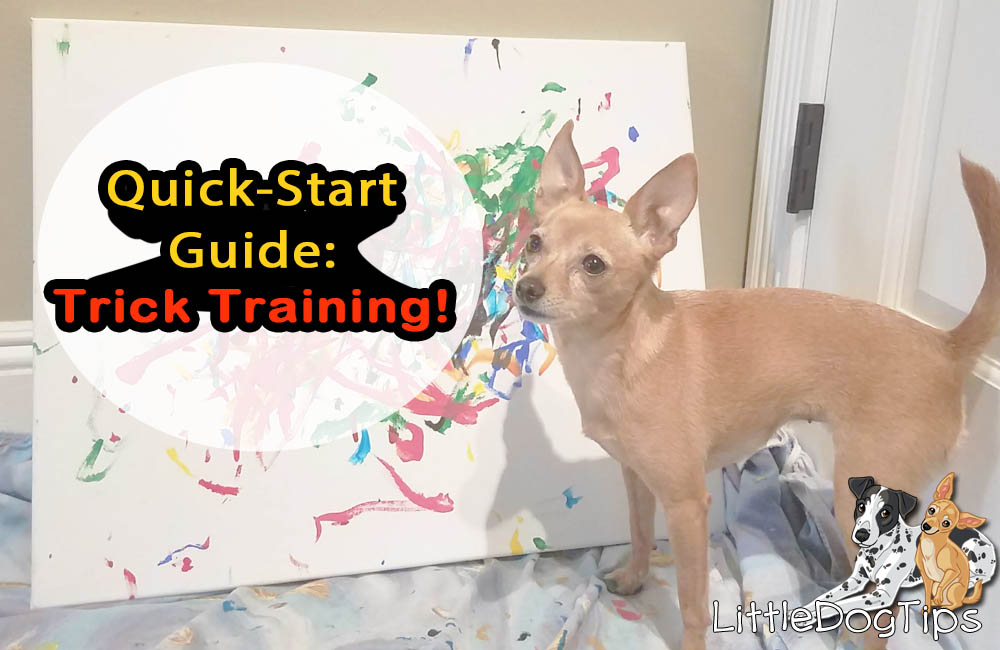
[ad_1]
Trick-training can unlock both your creativity and that of your dog’s.
That’s right – dogs can be creative, too!
As you teach your dog the basic cues like sit and stay, and move onto more advanced skills like teaching your dog to fetch or even teaching your dog to paint, you’ll start to notice how your dog solves problems and gains new skills.
You’ll also learn about her capabilities and what type of skills interest her the most.
For example, Matilda is much too small to learn fun tricks like getting a soda can out of a cooler, or putting laundry in the dryer, but she loves shrunken-down versions of just about any skill that a human could do.
And Cow can learn many of the same tricks as Matilda, but she lacks the attention span and motivation for multi-step skills. Instead, she prefers fast-paced, one-step tricks like her back up trick.
Starting To Teach Tricks – Foundational Skills
Before you can make real progress with trick training, you’ll need to become great at getting and holding your dog’s attention.
Small, strong-tasting treats are best. We love freeze dried minnows and chicken breast treats. You can even use cat lick sticks.
Highly food motivated dogs like Matilda will do anything for a treat, but you can also use verbal praise, toys, and even your dog’s environment to reward and motivate them.
You don’t need to practice every day, nor do you need to keep a rigid training schedule. Don’t be discouraged if you’re busy, not organized or just prefer spur-of-the-moment training sessions. Do what you can, when you can.
Teach Your Dog Words
Dogs actually respond better to visual cues like a hand signal than they do verbal cues, like a word. Even better – use both.
One common thing dog parents get wrong at first – we start repeating the cue over and over before our dog knows what it means.
The little-known key to getting your dog to understand you is to speak less when training. Give their brain time to process new words. Start with actions, then put a name to that action.
For example, when you’re teaching “sit” for the first time, you’ll first need to get your dog to sit. Usually we do this by holding a treat just above their nose so they must sit to look at it.
Only in the moment the dog sits, we would say, just once, “sit!” and immediately give her the reward.
With practice, our dogs start to think and process differently. They connect actions they already do naturally with words that we introduce into their vocabulary. This technique is the Rosetta Stone for dogs and their people.
Breaking Down The Trick
We don’t realize how many steps are involved in a task until we need to break it down for our dogs.
Let’s say we want a dog to learn to fetch.
The steps would be…
- Chase after the toy
- Pick up the toy
- Carry the toy back
- Place the toy in your hand.
To teach fetch, we use a technique called backchaining. This is when you reverse the steps, adding another step to the sequence until your dog can complete the whole routine.
Getting Creative With Trick Training
At the grocery store, I found a tiny basketball hoop set. Within minutes of bringing it home, Matilda figured out what I wanted her to do with it. She applied the skills she learned from putting her toys away to a smaller target, using her own mind and little assistance from me to learn how to play basketball.
There’s endless ways you can teach your dog to use regular household items and routines as learning opportunities.
Even obedience-related skills, that is, finding ways to get our dogs to stop unwanted behaviors, works best when we make it into a fun trick.
Instead of barking when a guest arrives, what if your dog learned to press a button?
Or when your dog greets you when you return home, they learned to bring you a toy, instead of jumping up and ruining your clothes?
The possibilities are endless. And the sparkle in your dog’s eye when they learn something with your help – there’s really nothing like it.
[ad_2]
Source link

